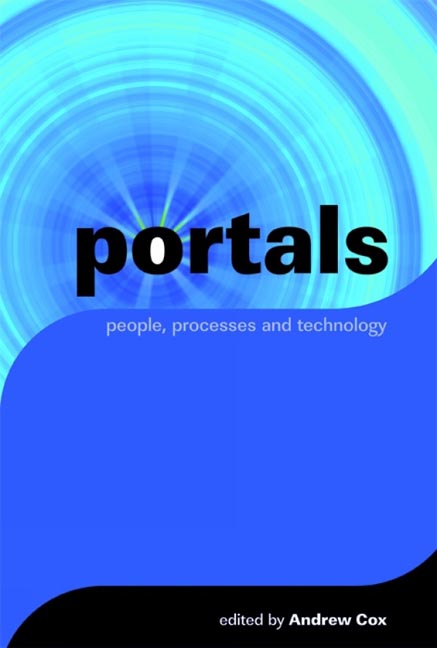Book contents
- Frontmatter
- Contents
- Introductory preface
- Section 1 Core themes
- Section 2 The library and the portal
- Section 3 The portal in the corporate sector
- Section 4 Portals in the public sector
- Section 5 The future
- 15 The future of portals?
- 16 Managing web-based information in an arts and humanities research environment
- 17 Portals and Web 2.0
- The contributors
- Index
17 - Portals and Web 2.0
from Section 5 - The future
Published online by Cambridge University Press: 09 June 2018
- Frontmatter
- Contents
- Introductory preface
- Section 1 Core themes
- Section 2 The library and the portal
- Section 3 The portal in the corporate sector
- Section 4 Portals in the public sector
- Section 5 The future
- 15 The future of portals?
- 16 Managing web-based information in an arts and humanities research environment
- 17 Portals and Web 2.0
- The contributors
- Index
Summary
Introduction
The discussion of portals throughout this book has revolved around the delivery of portal functionality through the world wide web. Portals have rarely been discussed in the context of client software that needs to be installed and run from the desktop. Certainly individual areas of functionality that are associated with portals – searching, news, information gathering – do have many desktop tools associated with them, but when it comes to drawing them together the web has been the platform of choice.
Bearing this in mind it is sometimes hard to believe that the web has been around for little over a decade in the form that we know and love. In that time there has been enormous change and the pace of this change shows no signs of stopping. From an innovation viewpoint this promises to deliver ever more powerful and flexible services: from a user's viewpoint this advance may be tempered by a concern that what is available today will simply be superseded tomorrow, requiring constant adjustment to the web landscape.
In a presentation entitled ‘The Open Source Paradigm Shift’, and later in a paper with the same title published on his website, Tim O'Reilly picked out a number of changes and developments in the field of open-source software development that had taken place in recent years, and identified some key trends. These were:
• software as commodity
• network-enabled collaboration
• customizability or software-as-service.
To sum these up software can no longer be regarded as the end in itself in building a solution. Software is the commodity that enables services to be developed, often by customizing and/or combining different pieces of software to build something new. This flexible and organic development path is facilitated through collaboration and it is the network that provides the means for that collaboration among developers across the world.
Although these trends were focused on open-source software they also have relevance to the development of the web, and indeed it is quite possibly the web, being the network it is, that has led open-source software in the direction he describes.
- Type
- Chapter
- Information
- Portalspeople, processes and technology, pp. 221 - 229Publisher: FacetPrint publication year: 2006



